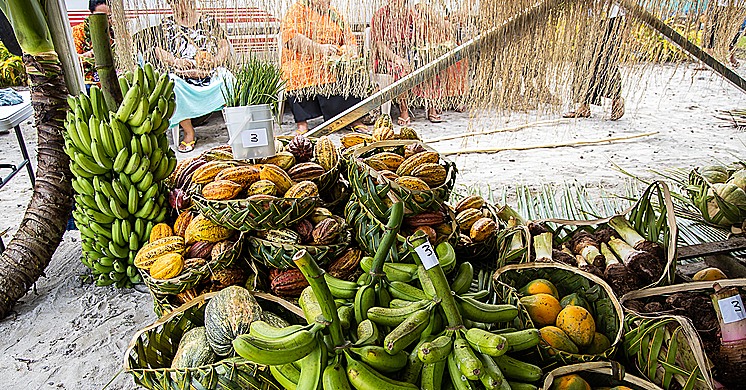O Tusitala Tellers of Tales: an interview with Rosaivitilesaualofaoleola Solomona
Rosaivitilesaualofaoleola Solomona, who is a music lecturer at the National University of Samoa (NUS), does the choreography for the dances in the play "O Tusitala Tellers of Tales" produced by Tise Saliga Fauolo and directed by Sia Figiel. In the interview below with Vanya Taule'alo, she talks about how she choreographs the dances. The play is scheduled to premiere on Tuesday 30 May, and Wednesday 7 June at the Blue Wave Theatre, Vaivase Uta.
VT. How do you go about creating the choreography for the dances in the play o Tusitala?
The guidance from the Director/Playwright was integral. I am fortunate to be working directly under Sia Figiel herself, and I try my best to understand her vision as much as I can as we have not worked before. The more she is able to express her vision, the better it was for me.
RS. How do you learn the steps for the dances?
These are all new choreography, so it is what I like to call the “experimentation” phase. It is a wonderful phase for my dancers and me to experiment with new things, especially exploring new ways of interpreting the words of the song and the idea of the scene.
VT. What style of dancing has inspired the dances you do in O Tusitala?
RS. The Director was specific about modern dance, the “experimentation” of choreography. I specifically chose to explore and incorporate a couple of Improvisation techniques where, in a specific phase of the first dance, the ideas are given to the dancers, and they have the chance to do some improvisation that is not choreographed. It allows the dancers to inject a bit of themselves into the work which is an important part of my creative process. Secondly, we have a modern approach to traditional songs, so we aimed to have a creative take on traditional motifs so as to have something new to something still very familiar and in context.
VT. Who created the music that accompanies the dance?
RS. The script is the most essential guide for this. The first dance is choreographed to the meter-free playing of the fagufagu (nose flute) that speaks of the time it comes from. The second dance is an old song/chant that is in the script so there was no need to create/compose a new song, but rather we created our own arrangement.
VT. Where did you learn to dance and perform?
RS. Hard to say, the arts have always been part of my life since I was very young. My parents were creative and academic, meaning that, unlike parents with talented kids, my parents pushed me into creative spaces (under specific artists and teachers) they analytically chose for my growth. They too were/are my biggest influencers and critics, so part of my learning to dance and perform was with them and or guided by them.
VT. What skills do you need to have to be a dancer?
RS. Firstly, one needs to be a born dancer. I believe and have seen that grace and passion are things that cannot be taught. Secondly, one needs to have the right attitude which includes the mindset that there is always space to grow and not be content with the limited knowledge he/she has. In this business of creative arts, only those with a healthy attitude toward training, open-mindedness to explore new things, and courage to defy the norms, make it.
VT. What are your greatest strengths as a dancer? What are your weaknesses?
RS. I have identified a few common weaknesses for dancers, especially for Pacific Islanders, as the age-old negativity toward plus-sized dancers. This is something that continues to be fostered by an ignorant society that we have to live in daily. Another is the lack of support from family who does not see the benefits of being a practicing creative and the career avenues available. A key strength that I, the NUS Dance Theatre, and many more, possess is our true Samoan/Island build. In the eyes of culture and our old people, grace was seen in the storytelling of thickened hips and shapely legs. This defies not only defies the insanity created to isolate a physical type of dancers but opens up endless opportunities for dancers like us to be in pioneering productions like this.
VT. Do you enjoy dancing and how does performing make you feel?
RS. I enjoy storytelling through dance, and it empowers me and the amazing creative people I am blessed to create magic with, fall in love more and more with who we are individually, and work together for a worthy cause.
• Sia Figiel grew up in Matautu Tai, on the island of Upolu, in Samoa. Her father was Polish -American and her mother was Samoan. Sia grew up surrounded by fagogo (legends and proverbs) and faleaitu. These stories dwelled deeply in her psyche, and she carries them close to her heart as they are a constant source of artistic inspiration and connects her closely to her culture. Sia is a novelist, performance poet, and playwright. This year Sia will travel to the Edinburgh Fringe Festival where she will perform her play O Tusitala; Teller of Tales. Dr. Vanya Taule'alo has lived over 40 years in Samoa where she is an artist, and educator, and has written widely on Samoan and Pacific art.










